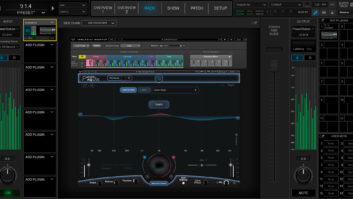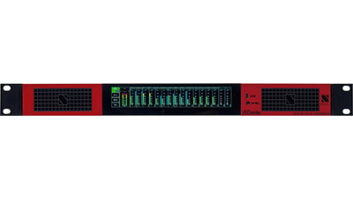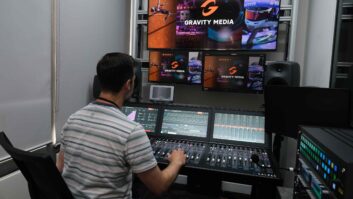In the final part of TVBEurope’s look at what topics may dominate the media technology industry in 2023, we cover everything from audio to UHD.
AUDIO
Einar Helde, co-founder of AIMS AI
With the continued growth of music releases across streaming platforms (Spotify’s latest figure is ~100,000 new tracks added per day) and audio-visual content distribution, we think AI-powered technology will play a big part in the curation of recommendations to audiences, to grow platform and artist engagement through the implementation of music search accuracy. Search plays such a big part in the discoverability of artists and songs, both for pleasure and in professional capacities (e.g., placing a track in adverts, TV shows etc.), the reliance on human-created metadata alone across such vast musical sources is impossible. Applying AI technology to support music release and discovery trends will be vital in 2023 and beyond.
Dave Letson, VP of sales, Calrec Audio
In 2023, we’ll further see an uptake in IP with a huge variation in the level and approach that customers take, as well as ongoing efforts with remote production. With regard to IP, it varies from customer to customer but ST 2110 is certainly happening and it’s happening on a wide scale. ST 2110 is now a standard requirement for broadcasters and there are many fixed and mobile reference sites demonstrating its versatility and success. As for remote production, it really took off during the pandemic (accidentally, some would say). Now it’s evolving further with the move to distributed production centres where surfaces, cores and their I/O are in different locations to suit the project needs. This can enable a greater use of equipment and a faster return on capital investment.
Rolf Martens, audio presales consultant, Jigsaw24 Media
Industry-wide adoption of AoIP, cloud storage and networking improvements will see a push towards decentralising process, I/O and Control in 2023. Virtualising these processes will allow post-production talent to focus on control and creative execution rather than managing technical infrastructure.
While AI-powered plugins for audio mixing have been around for a while, we expect to see an increase in both the development and adoption of these in 2023. Companies like iZotope use machine learning to automate analytical audio processes and, based on the increased adoption of AI-powered tools across the M&E industry over the last year, we anticipate that other players will enter this market in the coming year.
SUSTAINABILITY
Julie Selman, SVP head of EMEA, Magnite
The cost of living crisis is bringing energy consumption to the forefront of everyone’s minds. In 2023, we’ll see even greater awareness at consumer level on sustainability issues, and with this, consumers will demand the brands they love to operate in a more climate-conscious way.
A stronger focus on putting ESG policies into action is imperative. This will enable brands to align with consumers’ expectations. More research and information on the wider impact of ad-tech will emerge, further enabling action that will pave the way for significant and positive change.
Sustainability will become less intimidating, and more people will take small but meaningful changes that all build towards a more sustainable future.
THE MEDIA TECHNOLOGY INDUSTRY
Carol Bettencourt, VP of marketing, Chyron
A key trend moving into 2023 is a global labour shortage, projected to continue to 2030 and beyond. In the past broadcast organisations may have sought labour-saving workflows to reduce costs, today they may have no choice. To address this challenge, savvy broadcast technology innovators can creatively address this challenge in three key ways.
1 – Workflow efficiencies have long driven innovation and we will likely see continued leveraging of automated or macro-driven production, template-based graphics workflows, automated data integration and data driven automation.
2 – As young adults join the workforce or displaced workers seek new opportunities, technology vendors and broadcasters can benefit from both nurturing their talents and making training free and accessible.
3- Additionally, remote production workflows that have been implemented to avoid Covid exposure, save money and provide a greener alternative to OB trucks will continue, driven in part by labour scarcities. Broadcasters are no longer limited to a local talent pool or forced to incur prohibitive travel costs to assemble a production crew.
Johan Bergström, head of marketing and sales, Codemill
Media organisations are evolving their workflows to manage an increasing volume of content. As part of this industry trend, more organisations will leverage metadata in 2023, to improve the efficiency of content processing and fast-track media headed for new regions and new platforms. We have already seen OTT offerings adapt to an increasingly competitive landscape in 2022, with more entertainment choice and a mix of AVoD and SVoD models designed to attract new consumers. To service demand, M&E companies will need to streamline content operations and bring advanced media capabilities to their teams over the coming months.
Collaboration will be a key focus for media workflows, with better accessibility for users across departments and new connections between technology partners. Integration between vendors will provide the toolsets to deliver tailored workflows for specific requirements. The industry will also continue to see advances in automation around labour-intensive content processing. Repetitive actions such as; defining content duration to identify placement for ad-breaks, audio and subtitle syncing, or removing unwanted segments for compliance purposes, will become much more streamlined. Enriching media workflows in this way, will empower organisations to manage the challenges of content processing at scale – without sacrificing the quality of the final result.
Jon Finegold, chief marketing officer, Signiant
Given economic uncertainty, a theme that is likely to be prevalent in 2023 will be doing more with less. There will continue to be more content going to more places and media companies will be under pressure to deliver it all with the same or even fewer resources. Here are ways we see customers delivering:
Use elastic resources, automate, and cloud technology will continue to provide economic advantages for many workloads.
Mike Ward, head of marketing, Singular.live
Leading economic indicators suggest a global financial downturn in 2023. With instability comes tough decisions, particularly for those companies that are heavily leveraged and/or backed by investors. The economic downturn, the increased price of credit, and the reductions in production budgets are going to herald layoffs and selloffs in broadcast tech firms that are backed by PE and VC money.
As debt becomes more expensive and investors seek to consolidate their losses, the broadcast industry is poised for a period of consolidation and transformation. Although it will be a challenging period for some, it will ultimately help to accelerate the adoption of new and more sustainable approaches. We have ignored sustainability for too long, but the financial pressure will, in the end, compel more companies to act. Hopefully this will encourage broadcasters and industry colleagues to work together to develop different techniques and technologies that can be fully exploited to reduce the industry’s environmental impact.
WORKFLOWS
Stephen Tallamy, CTO, EditShare
In 2023, we will continue to see a very high reliance on collaborative workflows and automated content movement as projects are expected to be turned around much faster leading to a need to be able to seamlessly exchange projects between post production users and platforms. We will see more projects worked on in real time and synchronised with common edit platforms like Avid Media Composer, Adobe Premiere Pro and DaVinci Resolve – speeding workflows and boosting productivity.
Paddy Taylor, head of broadcast, MRMC
We forecast a wider adoption of automation in 2023. At MRMC, we have developed computer vision enabled robotic tracking camera systems that are dependable, consistent and can automatically track the subject of interest. Designed to capture the correct framing, regardless of whether it is a studio presenter, a footballer rapidly changing direction, or a horse on a racecourse. These systems are not only cost-effective but enable fast-response, smooth, fluid, human-like footage with low processing and minimal manual input requirements. Cameras can be placed where health and safety would prohibit, allowing for improved angles and variation of shots. Aside from the technical standpoint, automated camera systems have other benefits too. Coverage can significantly be increased without having to deploy additional camera operators. Which in turn, from an environmental standpoint reduces greenhouse gas emissions and helps the industry reduce its carbon footprint as we move to net zero.
Adam Leah, creative director, nxtedition
Data-driven workflows will be increasingly important in broadcast newsrooms in 2023. Data can be used to better understand the audience and tailor stories to their interests. Data can also be used to track viewership and engagement with stories, allowing news teams to quickly and easily identify which stories are resonating with the audience and which are not. Data-driven workflows will allow live graphics to create a two-way conversation with a viewer over social media and inject new life into linear broadcasting. The engagement is higher when viewers feel involved.
Automation will also become a major tool for broadcast newsrooms in 2023. Automated systems can be used to quickly produce stories from multiple sources and formats. Automation can also help to streamline workflows such as editing, approval processes, publish to third party APIs on web and social and create efficiencies in workflows allowing organisations to do more with less.
One version of a story can no longer satisfy all ages or platforms, so story versioning is also going to be an exciting new development. Effectively finding ways to fork a story for different demographics and social platforms through versions. It could be that it is built into a single story that is written to be segmented or different versions automatically generated into the long and short versions using machine learning. Essentially one size does not fit all anymore and newsrooms will learn to adapt the content to that philosophy.
UHD AND 8K
Laurent Petit, SVP markets and business alliances, EVS
Making the transition to UHD will be another important step for many broadcasters given the competitive nature of the video market. Up until now, broadcasters have been rather slow in their adoption of UHD. However, this is set to change due to the rising interest in UHD-native content that is driven by demand from streaming TV providers, and it’s only a matter of time before it becomes the new industry norm for resolution. The challenge, however, will be to find ways to create and manage the different formats and deliver monetisable content across multiple platforms more efficiently.
Julien Signes, EVP and general manager of video network at Synamedia
Whether you are watching a live event on a big screen outside the stadium or in a bar with others, you expect a premium experience and pin sharp quality. Fan zones are not just limited to popular sports – think Eurovision Song Contest and Last Night at the Proms with all those sequins and pomp in glorious detail.
That’s why we believe fan zones will drive the adoption of 8K for their big screens. We first demonstrated live sports streaming in 8K with BT in early 2022 and, through our discussions with operators, we all have high expectations for the next 12-24 months.
IP
Daniel Robinson, head of R&D, Pebble
We expect to see the growth in the adoption of virtualised playout workflows and the transition to IP-based systems in the broadcast industry. Improving interoperability between devices and fostering collaboration across the industry will also be important in 2023. Adopting open standards such as SMPTE 2110 and NMOS for on-premises installations, as well as new standards for cloud and hybrid systems, will support the transport of media between premises and the cloud and improve compatibility within the broadcast chain. And so finding trusted technology partners to assist in the transition to these new workflows will be a priority for broadcasters.
LOCALISATION
Louise Tapia, CEO, Take 1
In 2022 localisation services were characterised by massive demand and a lack of resources – trends that have been driven by an increase in both content streaming platforms and appetites for international content. The recent launch of the ITVX sign language channel – a world first – illustrates how content accessibility is now moving up the agenda and, in 2023, we expect to see the demand for access services also increasing significantly. The growth in accessible content production will extend beyond Ofcom and FCC requirements and we even expect to see live sports content becoming accessible this year – despite the challenges associated with producing live audio descriptions.
Unsurprisingly, technology, and AI in particular, will play an important role in increasing both localisation and access service capacities. The synthesised speech demonstrations that we witnessed at the IBC Show in September seem to indicate that this technology is now poised for mass adoption, a move that could impact not just the production of localised and accessible content, but the industry’s entire approach to talent management. It’s important to note, however, that human skill will continue to be important in 2023, particularly when it comes to nuanced translations and creating content like audio descriptions which are both an art and a science.






